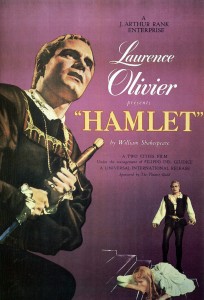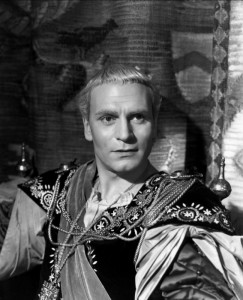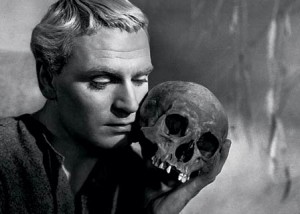 Hamlet, directed by and starring Laurence Olivier, is the first entirely British film to win the Best Picture Award.
Hamlet, directed by and starring Laurence Olivier, is the first entirely British film to win the Best Picture Award.
The film’s opening with Olivier’s voiceover of his own interpretation of the play–“This is the tragedy of a man who could not make up his mind”–was criticized as reductive:
Though the running time is 155 minutes, for the sake of brevity and dramatic impact, Olivier excised the “political” elements of the play, deleting entirely the characters of Fortinbras, Rosencrantz and Guildenstern in favor of a more intense psychological rendition.
Influenced by Freudian psychology, which was very popular at the time, Olivier emphasizes the Oedipal overtones of the play by having Hamlet kiss his mother on the lips; their intimacy is conveyed in several scenes, in which the two stand very close to (or touching) each other, as if they were enacting love scenes.
 Hamlet was shot in a different style than the actor’s 1946 Oscar-nominated “Henry V,” which was done in color. In this adaptation, Olivier used the camera as an active participant in the narrative, and shot in black and white, based on his metaphor for the movie Hamlet is like an engraving rather than a painting.”
Hamlet was shot in a different style than the actor’s 1946 Oscar-nominated “Henry V,” which was done in color. In this adaptation, Olivier used the camera as an active participant in the narrative, and shot in black and white, based on his metaphor for the movie Hamlet is like an engraving rather than a painting.”
The film’s visual style owes much to German Expressionism of the 1920s and American film noir of the 1940s. Olivier had said that the cavernous sets featuring narrow winding stairwells were meant to convey the labyrinths of Hamlet’s troubled psyche and mind.
Hauntingly photographed, the Castle, with its massive and gloomy corridors, framed the human characters in a cool, detached way, and the Oscars for Art Direction and Costume Design were well deserved.
Olivier is still the only thespian to win the Best Actor Oscar for a Shakespearean role, though other performers have been nominated.
 For this film, trying to be less recognizable, Olivier dyed his hair blond, though some later day critics consider his performance overrated.
For this film, trying to be less recognizable, Olivier dyed his hair blond, though some later day critics consider his performance overrated.
Hamlet is the only film to have won both the Golden Lion at the Venice Film Fest and the Best Picture Oscar.
Despite criticism of the 155-minute screen version, which omitted characters and whole scenes from Shakespeare’s play, “Hamlet” is still an exciting film, particularly when compared with Zeffirelli’s 1990 version, marred by the miscasting of Mel Gibson, as the melancholy Danish prince, and particularly Glenn Close, as Gertrud.
Oscar Nominations: 7
 Picture, produced by Laurence Olivier
Picture, produced by Laurence Olivier
Director: Olivier
Actor: Olivier
Supporting Actress: Jean Simmons
Art Direction-Set Decoration (b/w): Roger K. Furse; Carmen Dillon
Costume Design (b/w): Roger K. Furse
Scoring (Dramatic or Comedy): William Walton
Oscar Awards: 4
Picture
Actor
Art Direction-Set Decoration
Costume Design
Oscar Context
In 1948, “Hamlet” competed for the top Oscar with the ballet-drama “The Red Shoes,” which broke box-office records in the U.S.; two melodramas, Johnny Belinda” with Jane Wyman and The Snake Pit” with Olivia De Havilland, and John Huston’s brilliant crime drama, “The Treasure of the Sierra Madre,” with an all-star cast, headed by Humphrey Bogart and John Huston’s father, Walter Huston.
The most nominated picture was “Johnny Belinda,” receiving 12 nominations, but winning only one Oscar, Best Actress for Jane Wyman as the deaf-mute girl Belinda McDonald. The major awards were spread rather evenly among the five nominees. “The Red Shoes” deservedly won the technical awards in color, a distinction that increased the number of winning films.










